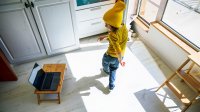A Look at How Arts Teachers Can Promote a Sense of Community
Arts teachers can help all students in a school feel that they’re part of a collaborative learning community, even when they’re not together.
Your content has been saved!
Go to My Saved Content.Arts teachers have challenges, even in normal times. Sometimes we have ample technology and resources; sometimes we don’t. We also have curricular standards and goals that matter, and sometimes they shouldn’t—at least initially.
With remote classrooms, the foundation of learning engagement is student investment, which grows out of caring and connection, and arts teachers have specific skill sets that can help grow a schoolwide environment that fosters connection if administration allows us to do so.
On a classroom level, I foster academic buy-in by creating lessons that link directly to an activity that we’ll complete when we return to in-person learning. For example, fourth-grade online activities include using a video tutorial called “Create a Rock Beat on Your Body.” I’ve set up a “rock band” with electric guitar, bass, and drums in my music room at school, so that when we return, students will arrive ready to take turns on my real drum kit using rhythms that they’ve already created online. Little Kids Rock has terrific activities like this to peruse.
Connecting on the classroom level is vital, but arts teachers can do even more. Connection is essential to developing a lifelong learner/creator, and music and art teachers are good at facilitating group connections. It’s in our DNA. We can sustain the larger learning community by fostering a sense of belonging. Unlike most classroom teachers, many of us have known every student for multiple years. This gives us opportunities to feed the heart and soul of our school—to sing songs and create projects, routines, and ceremonies that amplify our school culture for years on end.
Staff as well as students need to feel like they’re part of a collaborative community. Talking with teachers about how to enhance their online curriculum with a song or visual art project, for instance, can go a long way. Some of our art teacher’s recent remote work included having students create illustrations for our songbook.
Fostering a Collaborative Community
Connecting as a schoolwide community is even more important during this time of remote learning. Here are some specific things I do to build connections on an all-school level.
Organize all-school gatherings: I run regular all-school Zoom get-togethers that include curated and prerecorded class and individual presentations of songs and stories. Singing a popular school song on Zoom can bond us and lift spirits. The most requested song among our remote learners is “Hail Symonds School.” Getting classroom teachers and administration to agree on an open time that works for an all-school virtual gathering is key, as is posting about it frequently. Our event is attended by many teachers at my school who crave the real-time connection.
Attend classroom online morning meetings: I make it a goal to attend as many virtual classroom meetings as possible, so students can see that I’m part of their classroom and all-school community. This means I go where I’m not required and ask teachers if I can have five minutes of their morning meeting time.
Encourage kids to record songs, perform dances, and display artwork: I assign dances, hand-percussion challenges, freestyle rap exercises, and songwriting activities to present on video, which gives kids ownership. A class lesson with a simple activity, like composing and reading a two-line rhyming couplet for a song, can present an opportunity for voluntary sharing or performing. Sharing short clips of students with the remote online school community (with permission, of course) through assemblies is another way to promote connection.
Establish school community resources for creativity: I support the curriculum with arts activities and songs. For example, utilizing cross-curricular funds, I’ve created a songbook for every student to use at group all-school sings and presented edited videos of students performing at online all-school meetings. Our reading and media specialists have begun a remote “All School Read,” which has been very successful.
Create final all-school projects: Our arts team is working with the idea of each student painting a rock to create a garden display on our grounds. At the end of the year, if we are still remote, we will allow students to arrive on a staggered schedule and present their piece to the community.
We all have our limitations. Some kids in my district have little or no internet access, and technology in my school building is not ideal. Many of my fellow arts teachers don’t have the wide berth of experimentation that I have. Fortunately, I’m encouraged to think outside the box, and I have a budget for cross-curricular planning. Yet even without money and other resources, arts teachers can push for community gatherings and advocate to promote all-school online activities, especially in this disconnected time.
An arts curriculum is one of the most vital means to connect and can help show our children and our learning communities what we need locally and globally: love, compassion, and connection. Change is inevitable, and in times like these, artists can guide the way. As teachers of the arts, we need to look into the eyes of our children and ask ourselves, “What do they need right now?” We know that in this moment, they need connection.
